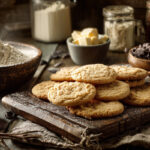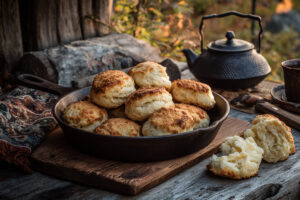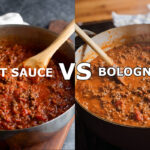Delicious, buttery cookies made entirely with shelf-stable ingredients – no fresh butter required!
Here’s something that might surprise you: some of the best cookies I’ve ever made didn’t use a single stick of fresh butter. Instead, they relied on powdered butter to deliver that rich, buttery flavor we all crave in a perfect cookie. And honestly? Most people can’t tell the difference.
These powdered butter cookies have become my go-to recipe for so many situations. When I’m camping and want fresh-baked treats around the campfire. When the power’s been out and I need to use up pantry ingredients. When I’m building emergency food storage but still want recipes that actually taste good. Or simply when I’m out of butter but have a serious cookie craving.
The secret to making these cookies work is understanding that powdered butter behaves differently than fresh butter in baking. Instead of creaming it with sugar like traditional recipes, you incorporate it into the dry ingredients, which creates a different but equally delicious texture. The result is cookies that are tender, flavorful, and surprisingly similar to traditional butter cookies.
Perfect Powdered Butter Sugar Cookies
Equipment
- Large mixing bowl
- Medium mixing bowl
- Measuring cups and spoons
- Wooden spoon or electric mixer
- Baking sheets
- Parchment paper
Ingredients
Base Cookie Ingredients
- 2 cups all-purpose flour
- 2/3 cup powdered butter
- 3/4 cup granulated sugar
- 1/4 cup brown sugar packed
- 1 teaspoon baking powder
- 1/2 teaspoon salt
- 1 large egg or 1 tablespoon egg powder + 2 tablespoons water
- 1/3 cup milk or 2 tablespoons milk powder + 1/3 cup water
- 2 tablespoons neutral oil vegetable or canola
- 1 teaspoon vanilla extract
Optional Add-ins
- 1 cup chocolate chips for chocolate chip variation
Instructions
- Preheat your oven to 350°F (175°C). Line two baking sheets with parchment paper or lightly grease them.
- In a large bowl, whisk together the flour, powdered butter, granulated sugar, brown sugar, baking powder, and salt. Make sure the powdered butter is evenly distributed with no clumps. If you see any lumps, break them up with your fingers or sift the mixture.
- In a separate bowl, whisk together the egg, milk, oil, and vanilla extract. If using powdered substitutes (egg powder or milk powder), make sure they’re completely dissolved before proceeding.
- Pour the wet ingredients into the dry ingredients. Using a wooden spoon or electric mixer on low speed, mix until a soft dough forms. The dough should hold together when pressed but not be sticky. If too dry, add milk one tablespoon at a time. If too wet, add flour one tablespoon at a time.
- If making chocolate chip cookies, fold in the chocolate chips now. For other variations, add your mix-ins at this stage. Don’t overmix – just fold until evenly distributed.
- Using a spoon or small cookie scoop, drop rounded tablespoons of dough onto your prepared baking sheets, spacing them about 2 inches apart. The cookies will spread slightly during baking.
- Bake for 12-15 minutes, until the edges are lightly golden but the centers still look slightly soft. Don’t overbake – they’ll continue cooking on the hot pan after removal.
- Let cookies cool on the baking sheet for 5 minutes, then transfer to a wire rack to cool completely. They’ll be soft when hot but will firm up as they cool to the perfect texture.
Notes
Why This Recipe Works
Traditional cookie recipes rely on creaming butter and sugar together to create air pockets that give cookies their texture. With powdered butter, we achieve a similar result through a different method. By mixing the powdered butter with flour first, then adding just the right amount of liquid, we create a dough that bakes into perfectly tender cookies.
What makes these cookies special:
- All shelf-stable ingredients – everything stores at room temperature for months
- Rich butter flavor – you’d never guess these weren’t made with fresh butter
- Perfect texture – tender and slightly chewy, just like classic butter cookies
- Camping friendly – make fresh cookies anywhere with basic cooking equipment
- Emergency prep approved – great way to use your powdered butter storage
- Incredibly versatile – endless flavor variations possible
Ingredients
For the Base Cookie:
- 2 cups all-purpose flour
- 2/3 cup powdered butter
- 3/4 cup granulated sugar
- 1/4 cup brown sugar, packed
- 1 teaspoon baking powder
- 1/2 teaspoon salt
- 1 large egg (or 1 tablespoon egg powder + 2 tablespoons water)
- 1/3 cup milk (or 2 tablespoons milk powder + 1/3 cup water)
- 2 tablespoons neutral oil (vegetable or canola)
- 1 teaspoon vanilla extract
For Chocolate Chip Variation:
- Add 1 cup chocolate chips to the base recipe
For Sugar Cookie Variation:
- Add 1/2 teaspoon almond extract
- Roll in coarse sugar before baking
Equipment You’ll Need:
- Large mixing bowl
- Medium mixing bowl
- Measuring cups and spoons
- Wooden spoon or electric mixer
- Baking sheets
- Parchment paper or cooking spray
Instructions
Step 1: Prepare Your Workspace
Preheat your oven to 350°F (175°C). Line two baking sheets with parchment paper or lightly grease them. If you’re camping, prepare your Dutch oven or camp stove setup.
Step 2: Mix the Dry Ingredients
In a large bowl, whisk together the flour, powdered butter, granulated sugar, brown sugar, baking powder, and salt. Make sure the powdered butter is evenly distributed with no clumps. If you see any lumps, break them up with your fingers or sift the mixture.
Pro tip: The powdered butter should look completely integrated into the flour mixture. This even distribution is key to consistent flavor in every cookie.
Step 3: Prepare Your Wet Ingredients
In a separate bowl, whisk together the egg, milk, oil, and vanilla extract. If you’re using powdered substitutes (egg powder or milk powder), make sure they’re completely dissolved before proceeding.
Liquid consistency check: Your wet mixture should be smooth and well-combined. If using egg powder, let it sit for a minute after mixing to fully hydrate.
Step 4: Combine Wet and Dry
Pour the wet ingredients into the dry ingredients. Using a wooden spoon or electric mixer on low speed, mix until a soft dough forms. The dough should hold together when pressed but not be sticky. If it seems too dry, add milk one tablespoon at a time. If too wet, add flour one tablespoon at a time.
Dough texture goal: You want a dough that’s soft enough to scoop easily but firm enough to hold its shape on the baking sheet.
Step 5: Add Mix-ins (Optional)
If making chocolate chip cookies, fold in the chocolate chips now. For other variations, add your mix-ins at this stage. Don’t overmix – just fold until evenly distributed.
Step 6: Shape the Cookies
Using a spoon or small cookie scoop, drop rounded tablespoons of dough onto your prepared baking sheets, spacing them about 2 inches apart. The cookies will spread slightly during baking.
For sugar cookies: Roll each ball of dough in coarse sugar before placing on the baking sheet.
Step 7: Bake to Perfection
For conventional oven: Bake for 12-15 minutes, until the edges are lightly golden but the centers still look slightly soft. Don’t overbake – they’ll continue cooking on the hot pan after removal.
For camping/Dutch oven: Use about 8-10 coals underneath and 14-16 coals on top. Bake for 12-18 minutes, checking after 10 minutes and rotating if needed for even browning.
Step 8: Cool and Enjoy
Let cookies cool on the baking sheet for 5 minutes, then transfer to a wire rack to cool completely. They’ll be soft when hot but will firm up as they cool to the perfect texture.
Serving and Storage
These cookies are delicious warm from the oven or completely cooled. They pair perfectly with milk, coffee, or hot chocolate around the campfire.
Storage: Store in an airtight container at room temperature for up to one week. For longer storage, freeze for up to 3 months.
Make-ahead tip: You can mix the dry ingredients ahead and store them in an airtight container for up to 6 months. When ready to bake, just add the wet ingredients and proceed with the recipe.
Variations to Try
Double Chocolate Cookies: Add 1/4 cup cocoa powder to the dry ingredients and reduce flour to 1 3/4 cups. Add 1 cup chocolate chips.
Snickerdoodles: Add 1 teaspoon cinnamon to the dry ingredients. Roll dough balls in a mixture of 2 tablespoons sugar + 1 teaspoon cinnamon before baking.
Oatmeal Cookies: Replace 1/2 cup flour with 1/2 cup old-fashioned oats. Add 1/2 teaspoon cinnamon and 1/2 cup raisins or dried cranberries.
Peanut Butter Cookies: Add 1/3 cup peanut butter powder to the dry ingredients. Press with a fork before baking for classic crosshatch pattern.
Lemon Cookies: Add 2 tablespoons lemon zest and replace vanilla with lemon extract. Roll in powdered sugar before baking.
Camping and Emergency Prep Notes
This recipe is perfect for situations where fresh ingredients aren’t available:
For camping: Pre-mix all dry ingredients at home and store in a sealed container. At camp, just add the wet ingredients and bake in your Dutch oven or camp stove.
For emergency prep: All ingredients except the egg can be stored long-term. Substitute egg powder for fresh eggs to make it completely shelf-stable.
High-altitude adjustments: Above 5,000 feet, reduce baking powder to 3/4 teaspoon and increase flour by 2-3 tablespoons.
Troubleshooting Common Issues
Cookies spread too much: Your dough might be too warm or too wet. Chill the dough for 30 minutes before baking, or add a bit more flour.
Cookies are too dry or crumbly: Add more liquid (milk) one tablespoon at a time to the dough.
Not enough butter flavor: Increase powdered butter to 3/4 cup, or add a bit more salt to enhance the flavors.
Cookies are too sweet: Reduce granulated sugar to 1/2 cup and increase the salt slightly.
Uneven baking: Make sure all cookies are the same size, and rotate your baking sheets halfway through if your oven has hot spots.
Nutrition Information
Per cookie (makes about 24):
- Calories: 145
- Fat: 4g
- Carbohydrates: 25g
- Protein: 3g
- Sodium: 125mg
The Science Behind It
The reason these cookies work so well is that powdered butter contains milk solids and has a different fat structure than fresh butter. When mixed with flour, it creates a more evenly distributed fat content throughout the dough. The small amount of oil adds moisture and helps bind everything together, while the milk provides the liquid needed to hydrate the powdered butter and create the proper dough consistency.
Why Choose Powdered Butter Cookies?
Beyond the convenience factor, there are some real advantages to this method. The texture is incredibly consistent from batch to batch because you’re not dealing with butter temperature variables. The flavor is evenly distributed throughout every cookie. And perhaps most importantly, you can make fresh, homemade cookies in situations where traditional baking would be impossible.
Ready to explore more powdered butter recipes? Check out our Complete Powdered Butter Bible for storage tips, buying guides, and 25+ more ways to use this versatile ingredient in your cooking!
Frequently Asked Questions
Do these really taste like regular butter cookies? They’re remarkably close! The flavor is definitely recognizable as butter cookies, though the texture is slightly different – perhaps a bit more tender than traditional creamed butter cookies.
Can I make these without eggs? Yes! Use 1 tablespoon of egg powder mixed with 2 tablespoons of water, or try 3 tablespoons of applesauce as an egg substitute.
How do I know when they’re done? The edges should be lightly golden, but the centers might still look slightly soft. They’ll firm up as they cool. Don’t wait for the centers to look completely set or they’ll be overbaked.
Can I double this recipe? Absolutely! Just double all ingredients. You might need to bake in multiple batches depending on your oven space.
What if I don’t have brown sugar? You can use all granulated sugar, but the cookies will be slightly less rich. Or make your own brown sugar by mixing 1/4 cup granulated sugar with 1 teaspoon molasses.
How long does the cookie dough keep? The mixed dough will keep in the refrigerator for up to 3 days, or you can freeze it for up to 3 months. Let frozen dough thaw in the refrigerator before baking.
Have you tried these powdered butter cookies? I’d love to hear about your results and any creative variations you’ve tried! Share your experience in the comments below.









